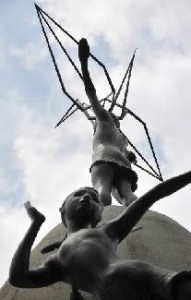- A-bomb Images
- Landmarks of Hiroshima: Children’s Peace Monument
Landmarks of Hiroshima: Children’s Peace Monument
by Kenji Namba, Senior Staff Writer
The Children’s Peace Monument measures 9 meters from its base to the paper crane at the top, held toward the sky in two outstretched hands by the bronze figure of a girl. Nearly every day, elementary school students and junior high school students, visiting Peace Memorial Park from both places in Japan and overseas, offer chains of paper cranes to this monument.
The model for the girl is Sadako Sasaki, a victim of the atomic bombing. She died in 1955 at the age of 12, ten years after being exposed to the bomb's radiation. Although Sadako was a fleet runner and loved sports, she was diagnosed with leukemia just prior to her graduation from Noboricho Elementary School, located in the heart of Hiroshima, and admitted to Hiroshima Red Cross Hospital. Sadako became captivated by some paper cranes that had been offered to the hospital, and eagerly began folding cranes of her own. [Japanese legend holds that the folder of a thousand paper cranes will be granted a wish.] Even as Sadako's health failed, she continued to fold paper cranes. After her death, a piece of rough paper was found in her room, revealing that Sadako had made notes on her blood cell counts to track the progress of her disease.
Sadako's classmates from the 6th grade, who went on to Noboricho Junior High School, decided that a monument should be raised in her honor. They distributed flyers at a nationwide conference of junior high school principals, held in Hiroshima one month after her death, and called for the creation of the Children's Peace Monument. This effort led to the establishment of the Hiroshima Society of School Children for Building World Peace, and resulted in fundraising activities across Japan for the purpose of building a monument to comfort the souls of all the children who perished in the bombing and to pray for peace. Over 3,000 schools offered donations for this cause and the monument was unveiled on May 5, 1958.
These words are inscribed on the monument: “This is our cry. This is our prayer. For building peace in the world.”
In 1977, Eleanor Coerr, a Canadian author, published “Sadako and The Thousand Paper Cranes,” a book that was subsequently translated into a dozen languages and made Sadako and her statue well-known around the world. Since 2002, the City of Hiroshima has tracked the number of paper cranes offered to the city. In less than 10 years, that number has exceeded 110 million.
(Originally published on July 4, 2011)
Effort to create Children's Peace Monument inspired action nationwide
The Children’s Peace Monument measures 9 meters from its base to the paper crane at the top, held toward the sky in two outstretched hands by the bronze figure of a girl. Nearly every day, elementary school students and junior high school students, visiting Peace Memorial Park from both places in Japan and overseas, offer chains of paper cranes to this monument.
The model for the girl is Sadako Sasaki, a victim of the atomic bombing. She died in 1955 at the age of 12, ten years after being exposed to the bomb's radiation. Although Sadako was a fleet runner and loved sports, she was diagnosed with leukemia just prior to her graduation from Noboricho Elementary School, located in the heart of Hiroshima, and admitted to Hiroshima Red Cross Hospital. Sadako became captivated by some paper cranes that had been offered to the hospital, and eagerly began folding cranes of her own. [Japanese legend holds that the folder of a thousand paper cranes will be granted a wish.] Even as Sadako's health failed, she continued to fold paper cranes. After her death, a piece of rough paper was found in her room, revealing that Sadako had made notes on her blood cell counts to track the progress of her disease.
Sadako's classmates from the 6th grade, who went on to Noboricho Junior High School, decided that a monument should be raised in her honor. They distributed flyers at a nationwide conference of junior high school principals, held in Hiroshima one month after her death, and called for the creation of the Children's Peace Monument. This effort led to the establishment of the Hiroshima Society of School Children for Building World Peace, and resulted in fundraising activities across Japan for the purpose of building a monument to comfort the souls of all the children who perished in the bombing and to pray for peace. Over 3,000 schools offered donations for this cause and the monument was unveiled on May 5, 1958.
These words are inscribed on the monument: “This is our cry. This is our prayer. For building peace in the world.”
In 1977, Eleanor Coerr, a Canadian author, published “Sadako and The Thousand Paper Cranes,” a book that was subsequently translated into a dozen languages and made Sadako and her statue well-known around the world. Since 2002, the City of Hiroshima has tracked the number of paper cranes offered to the city. In less than 10 years, that number has exceeded 110 million.
(Originally published on July 4, 2011)







